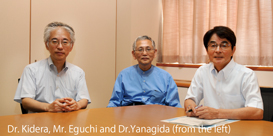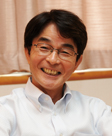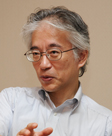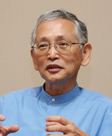 HPCI Strategic Program Field 1 Special Discussion
HPCI Strategic Program Field 1 Special Discussion
Pioneering the Future of Computational Life Science toward Understanding and Prediction of Complex Life Phenomena
HPCI Strategic Program Field 1 Supercomputational Life Science

Program Director of RIKEN HPCI Program for Computational Life Sciences Toshio Yanagida
Deputy- Program Director of RIKEN HPCI Program for Computational Life Sciences Akinori Kidera
Deputy- Program Director of RIKEN HPCI Program for Computational Life Sciences Yukihiro Eguchi
The HPCI Strategic Program, which aims to produce the world’s best research products in a wide variety of fields by utilizing Japanese High-Performance Computing Infrastructures (HPCI) centered on “K computer” and returning their fruits to society, got into full swing this year. What breakthrough will Field 1, “Supercomputational Life Science” bring to life science? We had Director Toshio Yanagida, Deputy Program Director Akinori Kidera, and Deputy Program Director Yukihiro Eguchi talk about that.
(This article appears in this and following numbers)
●Our goal is to recreate life phenomena on the computer.

YANAGIDA(Honorifics omitted) : In a nutshell, our dream is to reproduce life phenomena representing highly complex, non-linear and dynamic systems on the computer. It is our final target. For example, in order to reproduce various cell functions, we have to have enough data to input to the computer. Of course, we cannot understand the system only with the data, and need a concept to process and analyze the data. After formulating it properly, we set up a model based on it and reproduce cell functions with the computer. Of course, we want to reproduce not only cells but also tissues and organs, and that's not easy. Therefore, we must first have a firm understanding of partial functions such as protein functions and reproduce them on the computer. It would be wonderful if that could lead to drug discovery. Of course, we are interested in the way how complex movements of proteins lead to their function, but if we could manipulate protein functions, we would be able to expect to translate it into drug discovery.

KIDERA : I have been studying protein simulation. My final goal in the HPCI Strategic Program is the same as what Dr. Yanagida said. I want to replicate protein behavior plainly by simulating proteins in the computer. However, compared to other fields such as the materials field in which computational science is advanced, life science is still largely undeveloped. If I were to speak out without fear of being wrong, I would say that simulation of life phenomena is nearly impossible. Then, what is possible to us? I think our challenge started from here. It is difficult to replicate cell behavior. Then, how about the more limited case of a single protein molecule? Like this, we have studied what we can find by limiting the theme until we can handle and do the simulation properly. We made the theme smaller until we could handle it. As a result, what happened? It became a matter of physics, not biology. Everything starts from physics. However, many biologists ignored it completely. Then, what is different between life phenomena and physical phenomena? For example, nothing happens by putting a single protein into the computer and simulating it. A partner is needed to make something happen. To make the partner work, another partner is required. And then, that partner needs yet another one. Such a world of endless chain reactions takes place in an astonishingly complex and heterogeneous cell environment. Formerly, we were not able to observe it due to the limitation of computer power. With the increased computer power, the range that we can reproduce becomes larger spatially and temporally, and we don't have to minify the limitation. Now at last, biologists are starting to show interest. In the next step, we are going to observe something which is larger and more real with “K computer”. Our research level at last is starting to be recognized by biologists doing experiments. In addition, people in the fields of medical care and drug discovery, who thought they had nothing to do with computing, are starting to say, “Simulation may be useful” or “We may be able to do something interesting with K computer”. What was once thought to be impossible may become feasible or probable. Well, that's an overstatement (laugh).
YANAGIDA : If you say, “ Let’s improve this by five times,” you will have trouble dealing with the reality, but if you say, “By one hundred times,” you will feel relieved and get on with the research (laugh).
KIDERA : Since the level of the computer we used so far was 10TFLOPS and that of “K computer” is one thousand times higher, 10PFLOPS, more and more researchers should show an interest (laugh).
YANAGIDA : Aside from joking, it's actually very important that researchers think something is “interesting.” If they think simulation is interesting and useful, they come to think along those lines and their research may take a new direction.
●We will show that life science is becoming an information-driven science.

EGUCHI : Dr. Yanagida said i t's a dream, but I hope the day would come, when many researchers who once performed many experiments with trial and error say, “As I can now find the result of this experiment through computer simulation, I will leave it to simulation.” For example, the safety of automobiles is tested by collision experiments. It was once actually done with many automobiles to change collision angles and speeds, but today most experiments are done through simulation. This means that computer simulation has become that much more reliable. I hope something similar would happen in life science.
YANAGIDA : Right, in the field of manufacturing, half of the experiments are done by simulation. It is common to use simulation in experiments. In this regard, life science may be behind in computer science. However, life science will also follow the same pattern. It is impossible to replace everything, but we have to omit experiments and use simulation with determined parameters as much as possible. Then, the part we cannot simulate should be solved by experiments to increase efficiency, and especially in drug discovery. There are too many combinations for trial and error.
KIDERA : There is another important thing in addition to what Mr. Eguchi mentioned. I think it's to show that life science can be shown to be a science which utilizes information. This means improving on the limited way of conventional information processing with “K computer” change the image of information itself, and make what was once thought impossible, possible. I think it's one of the roles of the HPCI Strategic Program we are addressing to clearly point the way in this direction, and greatly expand the possibilities. It's important to show how to do data analysis or prototypes using massive computer resources like “K computer”, and widely demonstrate its possibilities and results to the outside. Also, I’d like to speak a little on what Dr. Yanagida said: life science lags behind manufacturing. Actually we are doing the same level of computation. However, it's not enough when we come to life science. So it seems we can only handle small things. For example, there is whole body-scale simulation. The human body basically looks similar to an automobile, but it's different from automobiles which are a combination of steel sheets and an iron frame - even an organ is a gathering of a lot of very, very many kinds of cells. In addition, heat and substances go in and out of the organ for chemical reactions. We must change our computations depending on what we observe. Anyway, it's a very difficult problem.
YANAGIDA : Its crucial difference from the other fields is that life science does not have fundamental equations. We can only search for parameters and find a certain predisposition or state of things. It's also difficult that what is going on has multiple factors. Since the targets of life science are very complex and difficult, we still have a long way to go. In addition, a high computing power is required due to many combinations. However, if we clear those obstacles and our research level reaches that of other fields, computer simulation would be able to do a lot of things, i.e., contribute to drug discovery.
●Can you do your studies without enjoying them?
EGUCHI : I t's tough e nough to a nalyze o nly p roteins. Cells have all sorts of other data. Dr. Yanagida, who is conversant with the difficulty of complex, varied and non-linear life phenomena, is head of the project and is always issuing communications. I think this is very important. By doing this, I believe that new ideas will come out of new data to lead to further research. In order to enliven this future Field 1, we will need to rebuild the path so that R&D teams bring up issues one after another, or newcomers can participate. This is a 5-year project, but I'd like to create a framework in which more new trends appear after the 6th year and there are more young researchers who want to participate in this field. Although the research is hard, I want to get it across to the life science community and young researchers’ communities that all members are actively getting results by making the best use of new computer power, and expanding the horizons of research.
YANAGIDA : Not only are researchers who are engaged in computer science backing this field, but many biologists who use computers today. So, promoting this trend leads to further improvement of science itself. However, it's no use only to say that computers are important. We need something playing the role of a driving force or becoming a base. I think that symbol is “K computer” which demonstrated a world-beating computing ability. Then, an actual project using “K computer” starts rolling, impressive research is being done there, and Japan has world-class researchers. I believe that is what is important.
EGUCHI : Now, “K computer” has become No. 1 in the world. Because of that, I’d like professors to get good research results.
YANAGIDA : Since this research resource became No. 1, it, of course, also hints that Japanese science research itself might become the world’s No.1. To achieve this, it's crucial to expand the horizons of interdisciplinary studies, for example a successful marriage of Science and Engineering.
EGUCHI : It's great to do research with world-beater “K computer”. I would like to see an environment in which researchers from various fields participate, compete with and complement each other.
KIDERA : It's true that along with an increase in computer power, we can not only do research in our field, but also do more advanced research. We can use “K computer”. This offers a great advantage for our research. For this reason, it may be the challenge of the future to build a system in which users do their research with a sense of thrill and excitement, not pressure, although it's my position to urge them to produce results (laugh).
EGUCHI : Please create an atmosphere in which everyone gets excited and wants to team up (laugh).
KIDERA : I really felt “K computer” was great when I put it into use. After experiencing the speed, I really felt it is a terrific computer.
YANAGIDA : The triple-digit difference from conventional computers makes you feel not only a quantitative difference but also a qualitative change.
KIDERA : Everyone gets the feeling they can get great results with it. That’s why they also feel pressured. I don't want to say, “Hurry up and get results,” as far as I can avoid it, but… (laugh)
YANAGIDA : As I recall, at the review board the other day someone said about a research presentation, “Research must be carried out with a sense of joy. Are you happy when you do your research?”
KIDERA : Of course we have responsibility, but after all you cannot do great things without enjoying them.
(Continued in the next issue)
BioSupercomputing Newsletter Vol.5
- SPECIAL INTERVIEW
- The time has come for biosupercomputing to get results with the world's No. 1 supercomputer
"K computer", and take up the challenge of "prognostic biology".
Deputy Program Director of Computational Science Research Program, RIKEN Ryutaro Himeno - What should we do to promote industrial use of sophisticated computer resources and development applications?
Chief Coordinator of Foundation for Computational Science Masahiro Fukuda
Chief Researcher of Urban Innovation Institute and Executive Board Member and Bureau Chief of BioGrid Center Kansai Ryuichi Shimizu
- Report on Research
- Analysis of molecular mechanism of enzymatic reactions by QM/MM Free Energy Method
Graduate School of Science, Kyoto University Shigehiko Hayashi (Molecular Scale WG) - Computational Mechanobiology of Actin Cytoskeleton
Institute for Frontier Medical Science, Kyoto University Yasuhiro Inoue (Cell Scale WG) - Development of Blood flow Analysis Method for Simulation of Thrombus Formation
Department of Mechanical Engineering, The University of Tokyo Satoshi Ii (Organ and Body Scale WG) - Development of Data Assimilation Technology for Simulation of Living Things
The Institute of Statistical Mathematics Tomoyuki Higuchi (Data Analysis Fusion WG)
- SPECIAL INTERVIEW
- Pioneering the Future of Computational Life Science toward Understanding and Prediction of Complex Life Phenomena
Program Director of RIKEN HPCI Program for Computational Life Sciences Toshio Yanagida
Deputy- Program Director of RIKEN HPCI Program for Computational Life Sciences Akinori Kidera
Deputy- Program Director of RIKEN HPCI Program for Computational Life Sciences Yukihiro Eguchi
- Report on Research
- Simulation Applicable to Drug Design
Research Center for Advanced Science and Technology, The University of Tokyo Hideaki Fujitani (Field 1- Program 2) - An Ultra-fast Analysis System for Next-Generation DNA Sequencer Data
Graduate School of Information Science and Engineering, Tokyo Institute of Technology
Yutaka Akiyama, Takashi Ishida, Masanori Kakuta, Shuji Suzuki (Field 1- Program 4)
- Report
- BioSupercomputing Summer School 2011
Computational Science Research Program, RIKEN Yasuhiro Ishimine (Organ and Body Scale WG)
Research and Development Center for Data Assimilation, Institute of Statistical Mathematics Masaya Saito (Data Analysis Fusion WG)
Niigata University of International and Information Studies Eisuke Chikayama (Cell Scale WG)
School of Medicine, Tokai University Yohei Nanazawa (Cell Scale/Organ and Body Scale WG)
Computational Science Research Program, RIKEN Takashi Handa (Brain and Neural Systems WG)
Computational Science Research Program, RIKEN Gen Masumoto (High-performance Computing Team)
Computational Science Research Program, RIKEN Kei Moritsugu (Molecular Scale WG) - “Next-Generation Integrated Simulation of Living Matter (ISLiM)”, a web page dedicated to new applications, has opened.
Computational Science Research Program Integrated Simulation of Living Matter Group
- Event information
